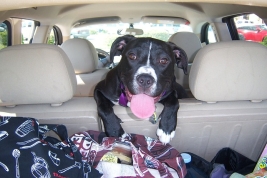PetFriendly.ca Home » Pet Travel Tips » Car Sickness & Fear of Riding in Cars
Car Sickness & Fear of Riding in Cars
By Marty Smith, DVM
Drs. Foster & Smith, Inc.

'Not every dog loves a face-in-the-wind car ride.'
For some dogs, car rides produce a great deal of anxiety.
A combination of fear and not understanding what is happening
will cause drooling, shaking, or even vomiting in some dogs
and cats. In humans, we refer to this as car sickness or
motion sickness; however, true motion sickness is a result
of an inner ear problem. Some dogs truly do have motion
sickness, and for these animals products such as Dramamine
can be used under the supervision of a veterinarian. For
most dogs, however, the sickness is strictly an over-reaction
to the fear and apprehension of the car noise, motion,
etc. If your dog would rather be anywhere besides in
the car, here is how you can help her overcome the
fear of car rides.
- Get your dog used to the car environment.
Get in the car together and have a treat. Talk. Be
happy. Make it a fun time. Do not have the car
running, just share a treat and make it a positive
experience. Repeat this a number of times on different
occasions. You may want to feed your dog in the car.
If your dog is afraid of even getting into the car,
try feeding or giving a treat close to the car.
- Get your dog used to the car while it is running.
Repeat step one, only this time start the car. Give a
treat before and after. If she looks or acts nervous,
reassure her that everything is OK. Take your time
and make sure she is relaxed before ending the session.
- Get your dog used to the motion of the moving car.
Once she is used to the car running without any fearful
reaction, back the car to the end of the driveway, then
forward again to the garage. Give her a treat and praise
her. Repetition is the key. The more you do this the
more confident your dog becomes that cars are no
problem. In fact, to her it becomes a great place for
attention, praise, and even treats.
- Now it is time to take a short trip around the block.
Treats and praise before and after, and calm, reassuring talk
throughout the ride are a pre-requisite. Gradually increase
the distance traveled until your dog is calm no matter how
long she's in the car.
Some animals still need something to calm them. There are
non-prescription products such as Serene-um, Pet Calm, and
Rescue Remedy. In severe cases, even stronger prescription
anti-anxiety medications can be dispensed by your veterinarian.
Get puppies used to the car while they are still young and
are more receptive to new adventures. Dogs make excellent
traveling companions so it is well worth the training now
for the years of enjoyment it will bring both of you once
you get over this obstacle together.
© 2005 Drs. Foster and Smith, Inc.
Reprinted as a courtesy and with permission from
PetEducation.com.
On-line store at
DrsFosterSmith.com.
Free pet supply catalog: 1-800-323-4208
